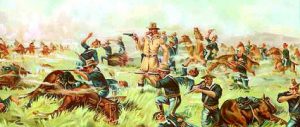In its current phase of rapid development, China often looks to the experience of western countries for inspiration. The development and nature-conquest of the western United States is sometimes seen as a model for China’s “Develop the West” campaign. The environmental clean-up that occurred after the western industrial revolution is often mentioned to defend China’s environmental crisis, in the hope that the emerging Chinese middle class will press for an “environmental Kuznets curve”.
However, using the west as a model for economic development and environmental restoration can be a grave mistake. In the United States, such development came at great cost for indigenous peoples and for the environment, damage that cannot be undone. The great wealth of the United States rests on an “original sin” of the theft of lands and resources of the millions of Native Americans who lived in America when white settlers arrived.
Today, legal challenges to that theft are still being contested in the courts, while the social and economic problems of the Indians who have been so profoundly victimised over the last two centuries remain an enduring stain on US honour and integrity and are a heavy and painful historical legacy. These injustices haunt our nation and cannot easily be rectified. Emerging economies aspiring to join a global community of civilised nations should learn from America’s errors.
A core theme of US experience in developing the west is the forcible relocation of Native Americans through atrocities such as the 1831 “Trail of Tears”, during which the Choctaw, Cherokee, Seminole and other nations were moved from the south-eastern part of the United States to what is today’s Oklahoma, thousands of Indians dying from disease and starvation along the way.
During the nineteenth century and early-twentieth century, the systematic effort to weaken and destroy Native Americans was official national policy. In the mid-nineteenth century, battles wiped out entire populations, including women and children, while “bounty hunters” were rewarded for each Indian scalp they produced. Other strategies involved eradication of traditional food animals such as the buffalo, theft and slaughter of horses (the Indians’ transportation for hunting and defence), and the deliberate introduction of smallpox.
Later, after the defeated Indians were squeezed into reservations, Native American children were forced into boarding schools where they were forbidden to practice their own cultural traditions or speak their native languages. The natives were gradually relocated into smaller and smaller plots of inferior land until the territory that they retained was only a tiny fraction of their former empires. The story is long, painful and twisted. Many promises were made and broken, many treaties signed and abrogated. As the Sioux leader Red Cloud said, famously, “They made us many promises, more than I can remember, but they never kept but one: they promised to take our land and they took it.”
This is a classic story of colonisation and imperial expansion. Political scientists say that states expand their territories in order to capture access to resources, to gain territory for excess populations, and to secure markets for trade. The story of the Lakota Sioux is just that, a struggle over land and resources that changed as new resources such as gold and uranium were discovered on lands formerly conceded to the Indians.
A huge population wave of white settlers travelling from the east in search of new lives ultimately doomed the Indians, leaving Red Cloud to comment in 1870, “The white children have surrounded me and left nothing but an island. When we first had this land we were strong, but now are melting like snow on a hillside, while you are grown like spring grass.” He further begged, futilely, “I have two mountains, Paha Sapa (Black Hills) and the Big Horn Mountains. I want the father (president) to make no roads through them.”
This is also a story of cultural genocide as white people, who claimed that they knew what was best for the “uncivilised” and “savage” nomadic peoples, forced the Indians into reservations, where they were made to give up their hunting culture. Above all it is a story which has resulted in six generations of complete dependency on the US government, decimation of tradition and identity and deep problems of unemployment, alcoholism, gangs, depression, factionalised tribal leadership and unfulfilled longing for justice and a return to former glory.
While I may seem critical or even biased, the US Supreme Court validated these criticisms in its 1980 decision on restitution for the illegal taking of the Black Hills, and the broad outlines of this history are commonly accepted. Unfortunately, many young Americans are not taught this history in their schools and many Indians today feel as if they are forgotten or invisible.
The Lakota Sioux were moved to reservations in South Dakota, in the mid-western United States, after lengthy struggles of resistance. I spent a week on the Pine Ridge Indian Reservation in May 2009 with a group of American University students seeking to understand efforts to improve the lives of the local people. The 13,000 square-kilometre reservation was created in 1889, and is the second largest Indian reservation in the United States. Pine Ridge is larger than the state of Connecticut, in the east of the country, and has a population estimated at more than 30,000, though the official figure is only 19,000 because many are homeless or avoid the census-taker.
The reservation is today one of the poorest places in the country, with an average annual income of only about US$3,000 (20,500 yuan) per capita, and its people are faced with social and economic problems as profound as any to be found in the developing world.
The teen suicide rate is among the highest in the nation, twice the national average; infant mortality is 300 times the national average; diabetes and tuberculosis rates are eight times the national average; alcoholism is rampant despite the ban on liquor within reservation boundaries, and unemployment is at 85%. Life expectancy for a male living on the reservation is only 46 years and for a female it is 49. Many homes have no running water or electricity, and racist violence is routine in neighboring towns and in Rapid City, the nearest large town. Although the tribal government is supposed to be “autonomous”, major decisions are controlled by the federal government’s Bureau of Indian Affairs (BIA).
Dislocations from native lands and transformations of familiar landscapes were important ingredients in creating the deep social problems that the reserve faces today.
Judith Shapiro is director of the Natural Resources and Sustainable Development MA Program at the School of International Service, American University, Washington DC.
NEXT: The consequences of displacement.
Homepage image by Sage shows a reservation flag.



